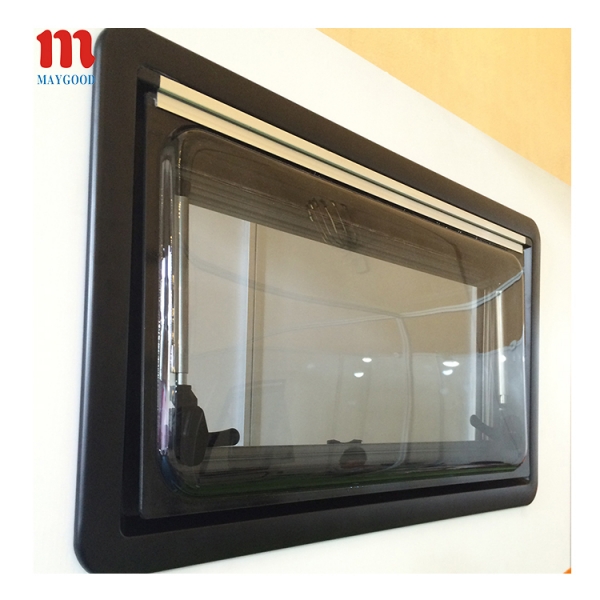Windows are a major source of cold air in a heated travel trailer or motorhome, but there are ways to reduce drafts and incoming moisture. At Crossing Creeks RV Resort, Eeven the Georgia mountains can get pretty chilly in late fall and winter for a Southern state.
One problem with RV windows is that build quality isn’t the greatest on many RVs, and the stress from frequent travel just make that worse. Try this: Buy canned smoke or light a match and blow it out, then hold it near a closed RV window, making sure not to get too near curtains. If the smoke seemingly disappears into the wall, it’s really making its way into cracks that let in winter’s cold and allow heat to escape.
Some RV window solutions are more expensive, but most are downright cheap. All will take some degree of work to make or install, but several aren’t particularly hard.
Double-Pane Windows
Most RV windows have a single pane—not the best at keeping out the cold. If you like a lot of light, bigger windows are a great idea—until winter hits. A single-pane window typically has an R value of 1, where R signifies resistance to thermal transfer, with higher numbers indicating more resistance. R-1 is perhaps 1/20 of the insulating value of a ceiling and a tenth or less of wall insulation. The bigger the window, the bigger the gap in your wall insulation.
Add to that the air leaks inherent in many RV window frames and you have a chilly RV.
Many RVers who have double-pane windows say they make a difference, but others warn that they damage easily. If shaking from travel breaks a seal, the windows can fog. Although they are typically rated only R-2, they have a space between them that is a vacuum or filled with an inert gas to reduce thermal transfer.
Double panes can be purchased and installed as replacements for your original single panes, but they are an easier solution when you buy an RV new because there’s no extra work to do. No, you’re not likely to buy a new RV just to get better windows, but they’re worth considering if you trade up.
If you install new windows, use adequate urethane caulking, which flexes, around the frame and under the trim to eliminate air leaks.
The big bonus of double-pane windows is that your RV interior will feel warmer but remain bright.
Reflective Barriers
Many RVers use bubble-type reflective sheeting, perhaps the best-known of which is Reflectix, over windows inside their RVs. Like a single pane of glass, bubble-type reflective covers probably have only an R-1 insulation value. But if installed properly, their effective performance, like that of double-pane windows, is higher.
The key is the material’s reflective value, not its insulating value. It will reflect heat away from its shiny side, so installing the shiny side toward the interior of your RV will reflect some of the heat back into the living space. Proper installation calls for an air pocket on each side of the cover. The air pocket is critical. The higher R-values claimed by manufacturers are based on the wrap not touching the window glass.
Methods of attaching Reflectix range from duct tape to Velcro and attaching a heavy cardboard frame, then hanging the assembly, sometimes with hooks and wires. You can find plenty of how-to videos online. The tighter the seal, the better reflective wrap works as a moisture barrier.
Some RVers use the reflective bubble wrap with extruded polystyrene foam sheathing to add insulation value. Mounting the foam against the reflective wrap does not lower its reflective property.
The most obvious negative in using reflective bubble sheeting or foam is that the interior of your RV will be dark.
Shrink-Wrap Plastic
Often used by owners of sticks-and-bricks homes, shrink window plastic also has little insulating value. Properly installed, however, it seals at least partly against air leaks and the resultant drafts, and it forms an air gap between the plastic film and the window pane to reduce temperature transfer. It’s a good seal against moisture.
Cut the plastic cover to the approximate size of the window frame and mount it as tightly as possible using double-sided tape. Then heat the plastic with a hair dryer to shrink it and draw it taught to the point that it is wrinkle-free. It’s intended to remain in place for the season—not good if you like to open your windows occasionally. You can always use a roof vent for some fresh air.
The plastic is clear, so it keeps your RV interior bright, although the view through the windows may be slightly cloudy.
Insulated Curtains
Providing some protection against temperature transfer are insulated curtains.
An online search yields an assortment of sticks-and-bricks window products, but a handy RVer could modify insulated curtains for camper use. Don’t think that blackout curtains are insulated; they’re not unless they are so labeled.
You can get some good tips on making insulated RV window covers here.
Alternative Solutions
If you don’t want to insulate your windows, insulate yourself. Dress in layers inside your RV when temperatures are colder. Woolens breathe better than acrylics, which can make some people sweat—not good when it’s cold.
At night, if you’re at a powered campsite, try an electric blanket. It’s pretty cozy under there. If you don’t want to go electric or can’t, at least get a heavily insulated, conventional blanket.
Photo Credits: alibaba.com
